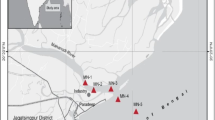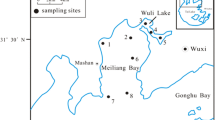Abstract
Phytoplankton variation in large shallow eutrophic lakes is characterized by high spatial and temporal heterogenity. Understanding the pattern of phytoplankton variation and the relationships between it and environmental variables can contribute to eutrophic lakes management. In this study Taihu Lake, one of the largest eutrophic fresh water lake in China, was taken as study area. The water body of Taihu Lake was divided into five regions viz. Wuli bay (WB), Meilian Bay (MB), West Taihu Lake (WTL), Main Body of Taihu Lake (MBTL) and East Taihu Lake (ETL). Concentrations of chlorophyll-a and the related environmental variables were determined in each region in the period 2000–2003. Factor analysis and multivariate analysis were applied to evaluate the interactions between phytoplankton variation and environmental variables. Results showed that the highest average concentrations of TN, TP and Chl-a were observed in WB, followed in a descending order by MB and WTL, and the lowest concentrations of TN, TP and Chl-a were observed in MBTL and ETL. Chl-a and TP concentrations in most regions (except ETL) declined during the study period. It suggested that to some extent the lake was recovering from eutrophication. However, persistent ascending of TN and NH4–N in all five regions indicated the deteriorating of water quality in the study period. Results of multivariate showed that the relationships between phytoplankton biomass and environmental variables varied among regions. TP illustrated itself a controlling role on phytoplankton in WB, MB, WTL and MBTL according to the significant positive relations to phytoplankton biomass in these regions. Nitrogen could be identified as a limiting factor to phytoplankton biomass in ETL in view of the positive correlations between TN and phytoplankton and between NH4–N and phytoplankton. Spatial variation of interactions between phytoplankton and environmental parameters suggested proper eutrophication control measures were needed to restore ecological system in each region of Taihu Lake.
Similar content being viewed by others
References
Abdul-Hussein, M. M., & Mason, C. F. (1988). The phytoplankton community of a eutrophic reservoir. Hydrobiologia, 169, 265–277.
Baines, S. B., Webster, K. E., Kratz, T. K., Carpenter, S. R., & Magnuson, J. J. (2000). Synchronous behavior of temperature, calcium, and chlorophyll in lakes of northern Wisconsin. Ecology, 81, 815–825.
Cai, Q. M., Gao, X. Y., Chen, Y. W., Ma, S. W., & Dokulil, M. (1997). Dynamic variations of water quality in Taihu Lake and multivariate analysis of its influential factors. Journal of Chinese. Geography, 7, 72–82.
Cao, C., Zhu, J. G., Zhu, J. Y., Cao, X., Dou, Y. J., & Hosen, Y. (2004). Nitrogen export from an agriculture watershed in the Taihu Lake area, China. Environmental Geochemistry and Health, 26, 199–207.
Chen, Y. W., Fan, C. X., Katrin, T., & Martin, D. (2003). Changes of nutrients and phytoplankton chlorophyll-a in a large shallow lake, Taihu, China: an 8-year investigation. Hydrobiologia, 506, 273–279.
Ellis, J. B. (1989). Urban discharges and receiving water quality impacts. Oxford: Pergamon.
George, B., Arhonditsis, M., Winder, M., Brett, T., & Daniel, E. S. (2004). Patterns and mechanisms of phytoplankton variability in Lake Washington (USA). Water Research, 38, 4013–4027.
Huang, W. Y., Wu, Y. G., & Shu, J. H. (1998). Hydrographical environmental problems and countermeasures of main lakes and reservoirs in China. Lake Science, 10, 83–90.
Jin, X. C., & Tu, Q. Y. (1990). Criterion of eutrophiction survey on lakes. Beijing: Environmental Science (in Chinese).
Lau, S. S. S., & Lane, S. N. (2002). Biological and chemical factors influencing shallow lake eutrophication: a long-term study. Science of the Total Environment, 228, 167–181.
Lewitus, A. J., Koepfler, E. T., & Morris, J. T. (1998). Seasonal variation in the regulation of phytoplankton by nitrogen and grazing in a salt marsh estuary. Limnology and Oceanography, 43, 636–646.
Lu, Y. (1998). Agricultural non-point pollution in Taihu basin and sustainable development. Chinese Environmental Science Trends, 2, 1–4.
Lu, H. C., Wang, F. E., Chen, Y. X., Zuo, M. Z., Fang, Z. F., & Zhou, G. D. (2003). Multianalysis between chlorophyll-a and environmental factors in Qiandao Lake water, China. Journal of Applied Ecology, 14, 1347–1350.
Ludwig, J. A., & Reynolds, J. F. (1988). Statistical ecology. New York: Wiley.
Luo, L. C., Qin, B. Q., & Hu, W. P. (2001). Wave characteristics in Taihu Lake. Journal of Hydrodynamics, 19, 664–670.
Luoma, S. N., & Bryan, B. W. (1982). A statistical study of environmental factors controlling concentrations of heavy metals in the burrowing bivalve Scrobicularia plana and the Polychaere Nereis diversicolor. Estuarine, Coastal and Shelf Science, 15, 95–108.
Pu, P. M., Hu, W. P., Yan, J. S., Wang, G. X., & Hu, C. G. (1998). A physico-ecological engineering experiment for water treatment in a hypertrophic lake in China. Ecological Engineering, 10, 179–190.
Romo, S., Van Donk, E., Gylstra, R., & Gulati, R. (1996). A multivariate analysis of phytoplankton and food web changes in a shallow biomanipulated lake. Freshwater Biology, 36, 683–696.
Sivonen, K., & Jones, G. (1999). Cyanobacterial toxins. In I. Chorus & J. Bartram (Eds.), Toxic cyanobacteria in water (pp. 41–111). London: WHO.
Sommer, U., Gliwicz, Z. M., Lampert, W., & Duncan, A. (1986). The PEG-model of seasonal succession of planktonic events in fresh lake. Hydrobiologia, 106, 433–471.
Strain, P. M., & Yeats, P. A. (1999). The relationships between chemical measures and potential predictors of the eutrophication status of inlets. Marine Pollution Bulletin, 38, 1163–1170.
Sun, S., & Huang, Y. (1993). Taihu. Beijing: Chinese Marine (in Chinese).
Thyssen, N. (1999). Nutrients in european ecosystems, environmental assessment report, vol. 4. Copenhagen: European Environment Agency.
Van, T., Van, L., Gulati, R. D., Postema, G., Boesewinkel, D., & Bruyn, P. J. (1992). Multivariate analysis of the plankton communities in the Loosdrecht lakes: relationship with the chemical and physical environment. Hydrobiologia, 233, 105–117.
Wang, J. (2000). Photoplankton and eutrophication in Taihu Lake. Journal of Wuxi Education College, 20, 90–92.
Wang, X. J., & Liu, R. M. (2005). Spatial analysis and eutrophication assessment for chlorophyll a in Taihu Lake. Environmental Monitoring and Assessment, 101, 167–174.
Wang, X. J., Zhang, W., Huang, Y. N., & Li, S. J. (2004). Modeling and simulation of point-non-point source effluent trading in Taihu Lake area: Perspective of non-point sources control in China. Science of the Total Environment, 325, 39–50.
Wu, S. C., & Chen, J. M. (2004). The periodic variation of phytoplankton in Taihu Lake. China Environmental Science, 24, 151–154.
Yu, D. H. (2000). The status and problem about eutrophic lake in China. Specialist dissertation of international learning workshop about eutrophical lake and its control technology in China. Dali China, 10(25), 207–214.
Yu, S., Shang, J., Zhao, J., & Guo, H. (2003). Factor analysis and dynamics of water quality of the Songhua river, northeast China. Water, Air and Soil Pollution, 144, 159–169.
Yuan, X. Y., Chen, J., Tao, Y. X., & Ji, J. F. (2002). Spatial characteristics and environmental implication of nitrogen and phosphorus from bottom sediments in northern Taihu Lake. Geochemical, China, 31, 321–328.
Zhang, Y. L., & Qin, B. Q. (2001). Study prospect and evolution of eutrophication in Taihu Lake. Shanghai Environmental Sciences, 20, 263–265.
Zhu, G. W., Gao, G., Qin, B. Q., & Zhang, L. (2003). Geochemical characteristics of phosphorus in sediments of a large shallow lake. Advance in Water Reach, China, 14, 714–719.
Author information
Authors and Affiliations
Corresponding author
Rights and permissions
About this article
Cite this article
Wang, X., Lu, Y., He, G. et al. Multivariate Analysis of Interactions Between Phytoplankton Biomass and Environmental Variables in Taihu Lake, China. Environ Monit Assess 133, 243–253 (2007). https://doi.org/10.1007/s10661-006-9577-y
Received:
Accepted:
Published:
Issue Date:
DOI: https://doi.org/10.1007/s10661-006-9577-y




